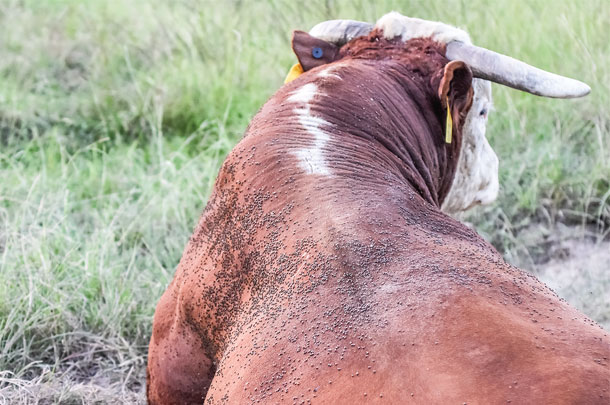Excessive horn fly populations can literally “suck” the profit out of your cattle operation. The horn fly alone is estimated to cause annual losses between $700 million and $1 billion to the U.S. beef industry. Losses tend to be greatest in lactating cows and growing calves.
Irritation and blood loss caused by biting horn flies can reduce calf weaning weights by 12 to 14 pounds and reduce average weight in yearling steers as much as 30 pounds.
 Horn flies also cause lowered sexual libido in bulls, resulting in reduced reproductive efficiency. Horn flies are also vectors for the transfer of diseases such as anaplasmosis, anthrax and mastitis caused by Staph. aureus.
Horn flies also cause lowered sexual libido in bulls, resulting in reduced reproductive efficiency. Horn flies are also vectors for the transfer of diseases such as anaplasmosis, anthrax and mastitis caused by Staph. aureus.
Understanding the horn fly
In order to combat the horn fly, we must understand its habits and life cycle. Adult horn flies are dark gray and about half the size of the housefly. The life cycle is completed in eight to 45 days, depending on temperature and humidity. Horn flies tend to rest quietly on the back and shoulders of cattle until disturbed.
Horn flies rarely leave their host except to lay eggs, to move to other cattle in the herd or when cattle enter buildings. Most feeding occurs along the underline of the animal and results in scabby, often bleeding, sores. Each fly is estimated to feed 20 times each day, significantly disrupting grazing behavior.
Horn flies survive the winter by remaining dormant as pupae in the soil. Adults emerge when average daily temperatures reach about 65ºF for a period of at least two weeks. In the Southeast, flies may remain active year-round. In general, fly populations tend to peak in early summer and decrease as conditions become hot and dry.
Fly control methods
Methods of horn fly control are many and varied, but most rely upon chemical control. Chemical methods in current use include: pesticide-infused eartags, pesticide sprays, pour-ons, backrubs and feed-through oral fly control.
Pesticide-infused eartags have been widely utilized with success historically. However, this method requires the labor and stress of handling cattle twice – once to apply the eartags and another to remove these tags.
Failure to remove eartags as recommended has widely contributed toward development of pesticide resistance and has reduced the overall success of this method over time.
Sprays and pour-on pesticides can also be effective; however, they also require extra labor and handling of cattle. Another point is that they offer short-term control (one month or less).
Therefore, in order for this method to offer optimum control, cattle must be handled and treated monthly throughout the fly season. Additionally, there is the fact that the applicator must handle these chemicals and the associated safety issues therein.
Some utilize backrubs laced with pesticides and oil. This method yields mixed results. It is difficult to get all cattle within the herd to properly utilize these rubs on a consistent basis. Additionally, labor is required to properly maintain these rubs to make sure they are not dislodged and contain effective levels of pesticides.
If you’re looking for effortless fly control without having to deal with sprays, pour-on pesticides or backrubs, self-fed, feed-through fly control supplements can be stress-free. These supplements contain active ingredients that interrupt the horn fly life cycle, effectively reducing the overall population of horn flies.
This method requires no additional labor and no cattle handling, unlike the previously mentioned methods. Just provide free-choice supplementation to cattle as you normally would.
The feed-through active ingredients currently approved for free-choice delivery are Rabon Oral Larvicide, Altosid IGR and Clarifly. All three active ingredients act to disrupt the horn fly life cycle to prevent future generations of flies.
All three active ingredients have no slaughter withdrawal times, and all can be fed to all classes of cattle including lactating cows and calves.
For best results, start feeding feed-through fly control products for at least 30 days before the projected last frost and 30 days after the first frost in the fall. In some areas, these dates will overlap.
Locate barrels or tubs where cattle congregate (near watering, loafing or shade areas, etc.). Follow label directions on stocking rates and target intake.
Increase or decrease the number of containers or change locations if necessary to adjust for proper consumption. Remember that feed-through fly control will not kill adult flies. Use of approved adulticides will be necessary to eliminate adult fly populations if these supplements are introduced after adult horn fly infestation is already established.
In summary, horn flies represent a costly drain on profitability. Fly control will be especially critical this spring due to ideal conditions for fly reproduction. Self-fed, feed-through fly control supplements are the most effortless and effective options available to cattlemen today. ![]()
PHOTO 1: Self-fed, feed-through fly control supplements are an effortless and effective option to control horn flies.
PHOTO 2: Horn flies are known to cause lowered sexual libido in bulls. Photos provided by Jackie Nix.

-
Jackie Nix
- Animal Nutritionist
- Crystalyx Brand Supplements
- Email Jackie Nix








